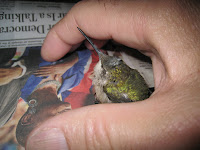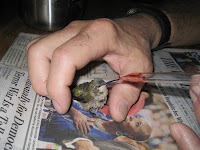 |
| Emergency Medical Transport |
"Thursday I found another dead hummingbird on the hangar floor. They can never get out, even with both big doors open. This happens once every week or two. I picked her up to toss her in the trash and she flopped once- still alive, barely.
I spent the next 90 minutes with an eye dropper filled with hummingbird nectar trying to revive her. She became more animated, began to flap her wings a bit, and finally flew off. Pretty neat...and surprising."
 |
| Catheter skills come in handy |
Fortunately, John's bird had relatively simple dietary needs in this crisis. Hummingbird feeder solution provided both calories and hydration. Hummers do consume insects, but during the current migration period they mostly need energy in the form of nectar, natural or artificial.
Here are some general hummingbird tips from our own Charley Burwick:
- Do the right 4:1 water and sugar mixture, do not use red coloring
- Keep the feeder fresh, usually in hot weather no longer than 2-3 days, clean with bleach, and rinse thoroughly
- Use a feeder hanging from the garage door, or even on the ground when a hummer is caught in the garage (common occurrence)
- Keep at least one feeder up until the end of the calendar year, you may get a rufous hummer that migrates this direction in the fall, and some ruby-throated are really slow leaving, especially the females, and first year birds.
As with deer in our suburban neighborhoods, we are having to learn to live with nature, and visa versa. Increasing human populations expand into what was previously wilderness. As our footprint on the planet increases with larger structures, taller glass buildings and more wind turbines, we will likely have more opportunities to deal with injured birds.
Wildbirdcarecentre.org has a lot of good information on the care of injured wild birds.